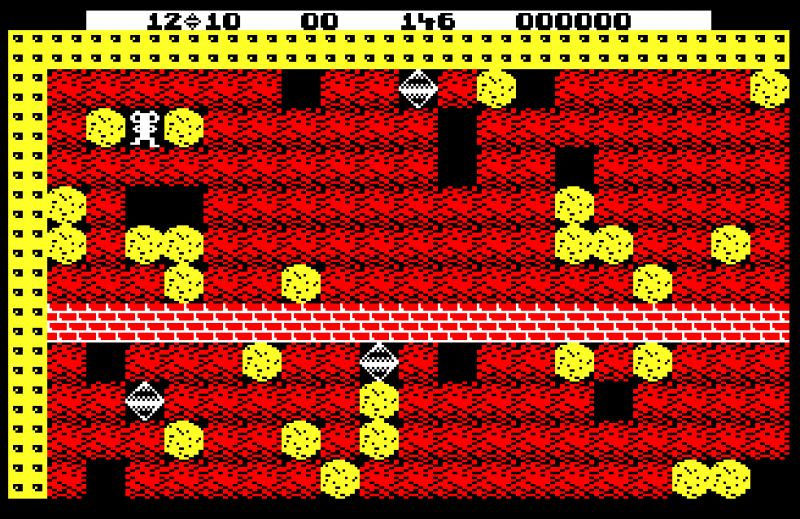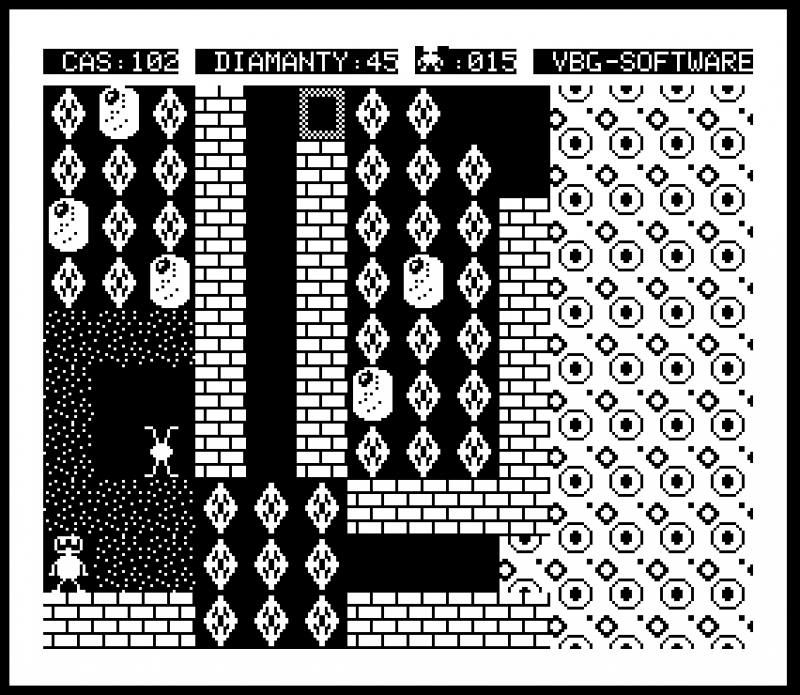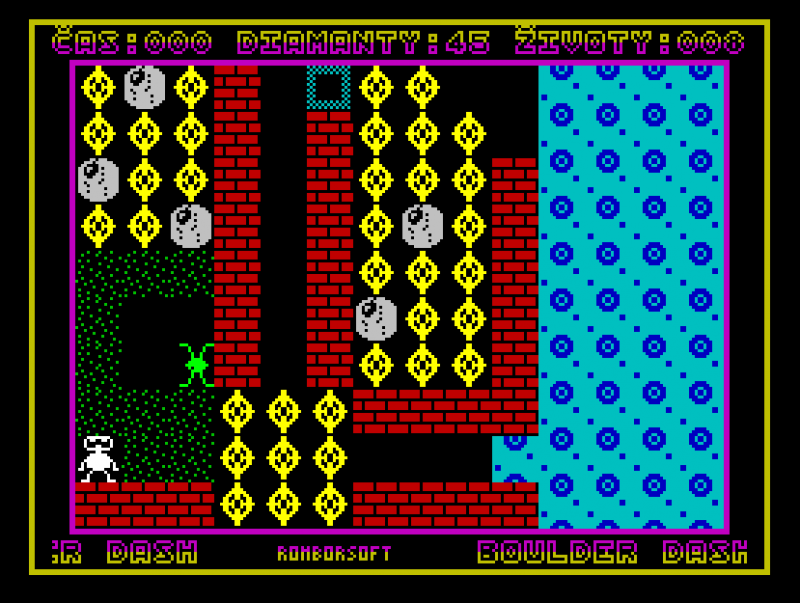Boulder Dash behind the Iron Curtain
It is a well-known fact that Boulder Dash was a big hit in North America and Western Europe. Much less known are Rockford’s adventures behind the Iron Curtain. My first encounter with Boulder Dash was in the early 1990s through an unofficial version for the Czechoslovak PMD 85 computer, a version that was very different from the original title. In this article, I would like to share some interesting findings about the various version of Boulder Dash made in Communist Czechoslovakia. I collected this information during my research on gaming in 1980s Czechoslovakia – much of which has been published in my book Gaming the Iron Curtain.
The original Boulder Dash was released in 1984 for the Atari 8-bit computers and later ported or converted to other popular platforms, such as the Commodore 64 or the British Sinclair ZX Spectrum. In Czechoslovakia at the time, there was next to no hardware or software market. Most computer fans self-imported 8-bit machines from the West. A few lucky ones had a permit to travel; others had to ask relatives, friends, or acquaintances who had it. Other options were the black market or specialized stores with imported goods, where one could only pay with special coupons. Despite the difficulties, tens of thousands of people in the country owned computers in the mid-1980s, most of them Sinclair machines, but also the 8-bit Atari models and the Japanese Sharp computers. Legitimate copies of software were sold nowhere in the country and the only way to get games was by informal means – by copying them from friends or from the software libraries of state-supported computer clubs. Until 1992, the Czechoslovak law did not recognize copyright of computer software and people were used to tinker with commercial programs and use them as material for their own hobby projects. Boulder Dash – and especially its Sinclair ZX Spectrum version – became very popular in the 1980s and early 1990s, as we can see on the example of three Boulder Dash versions made during that decade.

The first notable version was that for the Sharp MZ-800 computer, created by the Czechoslovak programmer Antonín Spurný from Roudnice nad Labem, a town 50 kilometers north of Prague. He was in his late twenties and worked as a chief electrician at a metal container factory while spending much of his leisure time as a computer hobbyist. He owned a Sharp MZ-800, a Japanese computer that had been imported into Czechoslovakia since 1986 to satiate the demand for home computers. The problem with the MZ-800 was that with next to no commercial software was ever produced for it. Most games available for this machine were legacy titles from the previous 8-bit Sharp models and unofficial ports from the Sinclair ZX Spectrum.
While generally incompatible with the ZX Spectrum, the Sharp MZ-800 had the same CPU, allowing Spurný to reuse most of the Spectrum Boulder Dash code for the Sharp version, save for the parts that handled controls, display, and sound. Spurný disassembled the code, identified key points where the program communicated with input and output of the machine, and rewrote them. He did not stop at building a working MZ-800 version but attempted to make it better than the original. To take advantage of the Sharp’s extra pixels, he modified the original code to display the game world in a 20×12 grid instead of the Spectrum’s 16×11 grid, allowing players to see a larger part of the environment. Incidentally, the original Atari version also displayed 20×12 tiles. In addition, he adapted the Spectrum’s version 1-bit beeper music to the MZ-800’s three channels, once again approximating the Atari original.

In the same year, another game called Boulder Dash was released by the VBG Software collective for the Czechoslovak PMD 85 machine, which was never sold on the consumer market, but was available at schools and computer clubs. VBG Software was a trio of young hobbyists – Vlastimil Veselý, Libor Bedrlík and Ladislav Gavar – from the city of Ostrava who remade several remakes from other computers to the PMD, including Manic Miner, Penetrator, or Saboteur. Their version of Boulder Dash was written primarily by Ladislav Gavar, whose remakes tended to be rather loose. According to Veselý, Gavar enjoyed “combining elements of other games with his own ideas” and “gradually moved away from copying foreign templates.” VBG’s Boulder Dash is, in fact, a completely new game based on the same (or similar) mechanics. The graphics are similar but monochrome, clearly inspired by the original but likely drawn from scratch without using bitmaps from the licensed versions. The levels were completely different. While the original game had 16 large levels, the PMD 85 version has 68 levels comprising of just 14×10 tiles so that they can fit onto the screen, likely because PMD 85 was too slow to implement scrolling. As a result, the levels in the VBG version are each built around a single puzzle or challenge rather than encouraging the more open-ended gameplay of the original. There is an element of choice, though: levels can be accessed from a separate labyrinth and one can choose which one to tackle first. Many schools in Czechoslovakia were equipped the PMD 85 and carried this version of Boulder Dash. For many Czechoslovak kids like myself, the VBG version was the first variant of Boulder Dash they encountered.

Roman Bórik from the city of Košice played the VBG version on a PMD 85 in a youth computer club and found the game instantly “spellbinding.” Although he later encountered the properly licensed versions of Boulder Dash, these could not outshine the magic of the first contact. In 1993 – as 8-bit computers were slowly becoming obsolete in Czechoslovakia – Bórik converted the VBG version back to the Sinclair ZX Spectrum. He kept all of Gavar’s levels and mechanical quirks but redrew the graphics. Somewhat confusingly, even this game bore the title Boulder Dash. Although there was already a nascent game industry in the country after the switch to a free market economy, this version was released as freeware similarly to the previous two.

All of these versions contributed to the fame of Boulder Dash in former Czechoslovakia. They show that local fans did not just enjoy Boulder Dash, but also wanted to make it available on other platforms, and to improve it, reimagine it, and build on its unique and captivating gameplay. Of course, Boulder Dash was not the only game converted and remixed by Czechoslovak hobbyists – another good example would be Manic Miner, which spawned even more domestic versions. Czechoslovak programmers also used the knowledge they gained while tinkering with Western games to make their own titles – and you can read more about those in my book or check them out on its website.
by JAROSLAV ŠVELCH, Ph.D.
New media and digital games scholar, Assistant professor, Faculty of Social Sciences, Charles University, Prague (Article published in 2021)

Boulder Dash® is a trademark of BBG Entertainment GmbH, registered in the US, the European Union and other countries. Boulder Dash® 30th Anniversary™, Boulder Dash® Deluxe™, the names and likenesses of Rockford™, Crystal™ and Goldford™ are trademarks of BBG Entertainment GmbH. Boulder Dash® 30th Anniversary™ and Boulder Dash® Deluxe™ Copyright © 1984-2025 BBG Entertainment GmbH. All rights reserved. The original Boulder Dash® was created by Peter Liepa with Chris Gray.